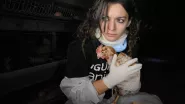Photojournalism was once the main vehicle of delivering visual information about worldwide events. It is still prevalent of course, but as widely reported, the world of photojournalism as it was once known is changing rapidly. The decline of print-based media has an obvious effect as pre-Internet, newspapers, television and magazines were how people received their global and local news. The photographs shared were important and shaped how we viewed events both in the moment and historically. Inevitably, the rise of collaborative journalism, or citizen journalism as it sometimes referred, has contributed to the demise of standalone photojournalism of the past. Citizen journalism is the photographic contributions of the general public. Think of the lo-fi phone photos and videos we regularly now see on news reports, the ‘on the ground’ approach can hold more presence in multiple locations and be sent in an instant, from multiple viewpoints. This of course hasn’t replaced photojournalism entirely as there is always a need for photographers capturing things with purpose and need rather than a case of being in the right place at the right time. The authenticity of photography is a long-standing issue, and this is of particular concern in a world littered with fake news and misinformation. The types of crimes that being reported on are changing also, with traditional warfare and physical unrest being countered with digital crimes. There is a question of how these crimes can be captured in a photojournalistic way, and whether or not there is even a need to. Despite the changes to traditional photojournalism, there has been a measured rise in the use of picture-led story telling on a local level in the form of the photo essay. These are stories that blur the line of photojournalism and documentary photography, a path that I feel many photographers are turning to during the decline of traditional photojournalism. They are often slower in pace and delivery, yet the subject matter is poignant and important. Their output no longer takes the shape of a printed newspaper, rushed and finished in the early hours, but that of a more carefully curated online feature or perhaps through social media and websites alone.

Photographer Joanne Coates has dedicated her recent practice to documenting rural populations and the issues that rule their livelihoods. By doing so, she is giving voice to communities that often are overlooked in visual storytelling. These people, from fishing communities to the farming communities do not provide the ‘big stories’ needed by everyday finger on the pulse journalism nor do they get hounded by the reporting tactics of citizen journalists, but instead hum gently in the background of life. It is for this very reason Coates works so passionately to share their stories through her photography. During the lockdown period in the UK, Coates turned her camera to a rural bus route and hub that provided a lifeline for the rural community it served. This area cannot be reached by delivery trucks so being able to access the bus did quite literally save lives. Coates’s approach through her camera shows her care, concern and passion for the rural communities, never once feeling intrusive or voyeuristic. Her rapport and relationship with her subjects are palatable in the imagery. Coates is a self-professed photographer who approaches ‘everyday stories with a documentary style’ puts social change and marginalised groups at the forefront of her practice. In a time of global change and a shift in focus and perspective for most, Coates’s practice shows us what photojournalism could be in the future. Looking inward and turning our attention to the everyday, our community, our street. Nothing has compared to the community spirit and help that has taken place during the Covid-19 pandemic, people coming together to celebrate the NHS, the delivery workers, the previously ignored. If more people shone their light on these groups in the way Coates does, it might just make for a better place.




